This project was inspired by my ‘Art Nouveau’ dresser. I was moving houses and had to pick the dresser up. These old wood dressers are extremely heavy with all their drawers even with nothing in them. So this got me thinking about what I could make to eventually get rid of the dresser when I had to move again. I came across the floating nightstand.
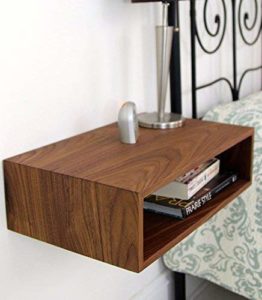
These nightstands can be priced from $200 all the way up to well over $1000. Most hanging desks are sold on etsy and are hand made. These floating night stands eliminate all the unused drawers, but leave room to place your glass of water at night, or charge your phone. Therefore, I modified this hanging night stand and added a stationary light with an LCD screen built in. I could always buy an LCD light and place it on this desk, but I wanted to build one.
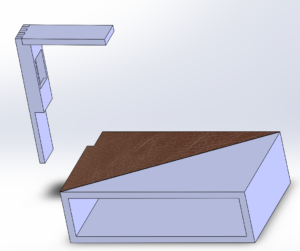
The first things I did was CAD model what I wanted the light to look like. I assembled all the dimensions and figured out how I would want to use this. I then purchased a 5’x5′ piece of ‘Birch Plywood’ and started to see how big this night stand was going to be. I cut each piece of wood ~2-3 times for precision on a table saw for the width. Then I laid the pieces on a chop saw and cut them to length. I then painted and assembled the bottom and the two sides shown in the photo below.
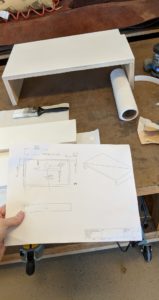
I then focused on the top of the night stand. I wanted the night stand to have wireless charging but also have a strip of LED’s so I could see what I had put in the space contained by the night stand. These tolerances were kept tight by creating the tool paths and using a CNC router.
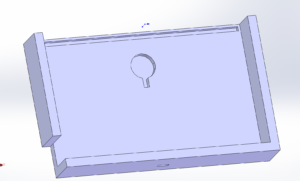

The wires for these components will be hidden behind a false back added in later in the design process. After this was designed the electronics needed to be finished. These would determine how big the false back would need to be, and how wide the light was going to be. For this part I hired the help of my partner who is an electrical/computer science engineer.
We first started out by using a raspberry pi zero along with a compatible 3.5″ RPi LCD. However, the raspberry pi zero ended up not working because its processor was not powerful enough to run raspian(the operating system needed for raspberry pi to function properly) in desktop mode. Therefore we settled with a regular raspberry pi 3b.
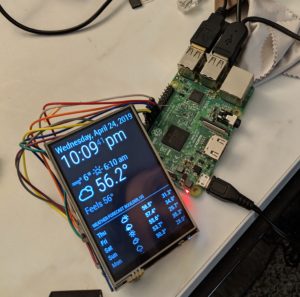
To plug the wires into the LCD from the raspberry pi, we had to unsolder the previous hat and change it to pins. This allowed the pins to interface with the wires that led to the raspberry pi. To figure out which wires went where on the raspberry pi and LCD, the schematics/chart below was used. These diagrams were necessary since the header sits on all the pins, but no all pins were used. Only 9/26 pins were used for the intended purpose.



The first step was to install Raspian(the operating system) onto the Raspberry Pi. Once this was done the driver for the LCD needed to be installed onto the Raspberry Pi. The drivers can be found: https://www.waveshare.com/w/upload/1/1e/RPi_LCD_User_Manual_EN.pdf?fbclid=IwAR3oS33DR0WYgpUAs7XFquGG72Rago0QFsEyFSdGtOds6OPFM43EItu9z8s.
With the drivers installed, the output to the LCD display could be tested. When the display was seen to be working the orientation of the screen had to be changed since the default was in landscape mode.

With the screen tilted the right way, Magic Mirror could be installed. Instructions can be found here: http://www.bujarra.com/instalando-configurando-magic-mirror-raspberry-pi/?lang=en&fbclid=IwAR3AHXetk9Ik3X9vx-vCX47Hh3hN8OajeBiy0c4ScwiUKCgI7JcVFP9LsLw. Magic Mirror is a DIY open source software used for specific applications involving time, weather, and daily updates displayed on an LCD.
To ensure that the Raspberry Pi auto-started, further software needed to be installed called PM2 (a production process manager). The instructions for this can be found: https://www.magicmirrorcentral.com/complete-raspberry-pi-magic-mirror-tutorial/?fbclid=IwAR1J253ZW9WdqrWyihqkUQtYlWjuQPaUn18frTAkcu-XfSfAa144pcaRqvU. PM2 is for node js applications, like magic mirror, used to ensure the program would automatically relaunch if the system crashed or shut off at any point in time.
After PM2 was installed and Magic Mirror successfully booted, configuration of Magic Mirror was needed. The default configuration of Magic Mirror needed to be configured since the size of the LCD screen chosen could not contain all the default programs. This was done by editing the custom java script and css files to make the font the right size and the padding smaller. This ultimately allowed the text to adopt symmetry. Another modification to the code was deleting a lot of the default and adding synchronized time and weather forecast. This was done by downloading new modules and pulling API keys from https://openweathermap.org/city/5574991?fbclid=IwAR2qfBTs1v-UuLWC8G1TvX5wMbv2Q7zLoGOM96pObqW6algdZKQgrkLtuYU.
If given more time, I would go back and try to get raspberry pi zero to work with my LCD. However, this would take a lot more troubleshooting and steps that are more time intensive than the time available.
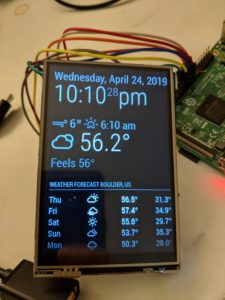
Now that this was done, the light could be fully assembled with the right dimensions. This was done by making finger joints using a finger joint machine, router, and band saw.
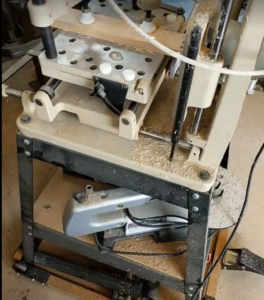
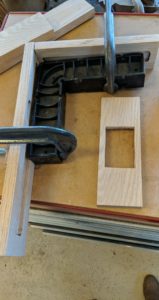
The leather vinyl was then added, and everything was nail gunned and glued together.
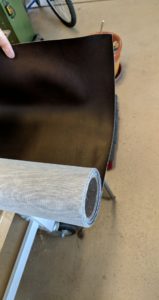
Overall, this project was a lot more time consuming than I had originally imagined it to be. However, I am very proud of the end result.
Budget:
Vinyl $18
5×5 Birch Plywood $60
Veneer $15
LCD $25
Arduino $30
Raspberry pi zero $10
Power chord $5
Total: $136
Acknowledgements: My dad, Jon Bork, for letting me use his machine shop and my partner, Maxwell Moroco, for helping with the electronics and programming.
Presentation on YouTube: https://youtu.be/_1Er7qREk2o
1. https://www.amazon.com/Floating-Nightstand-in-Solid-Walnut/dp/B07D716XD7
2. https://www.jameco.com/Jameco/workshop/circuitnotes/raspberry-pi-circuit-note.html?fbclid=IwAR3LLCM91dGRc6xNf9ez3Sj84da9Kq7XRKLr2wgb_eQ9p_MYCugyu8zIvGk
3. https://github.com/MichMich/MagicMirror/tree/master/modules/default/weatherforecast?fbclid=IwAR2Wwo88jKHVau3iYzG8pA9Tx68rFWGVZqc-6wqgI8I8cJXTd26XF8tQcLs
4. https://www.waveshare.com/w/upload/1/1e/RPi_LCD_User_Manual_EN.pdf?fbclid=IwAR3oS33DR0WYgpUAs7XFquGG72Rago0QFsEyFSdGtOds6OPFM43EItu9z8s
5. https://openweathermap.org/city/5574991?fbclid=IwAR2qfBTs1v-UuLWC8G1TvX5wMbv2Q7zLoGOM96pObqW6algdZKQgrkLtuYU
6. http://www.bujarra.com/instalando-configurando-magic-mirror-raspberry-pi/?lang=en&fbclid=IwAR3AHXetk9Ik3X9vx-vCX47Hh3hN8OajeBiy0c4ScwiUKCgI7JcVFP9LsLw
7. https://www.magicmirrorcentral.com/complete-raspberry-pi-magic-mirror-tutorial/?fbclid=IwAR1J253ZW9WdqrWyihqkUQtYlWjuQPaUn18frTAkcu-XfSfAa144pcaRqvU

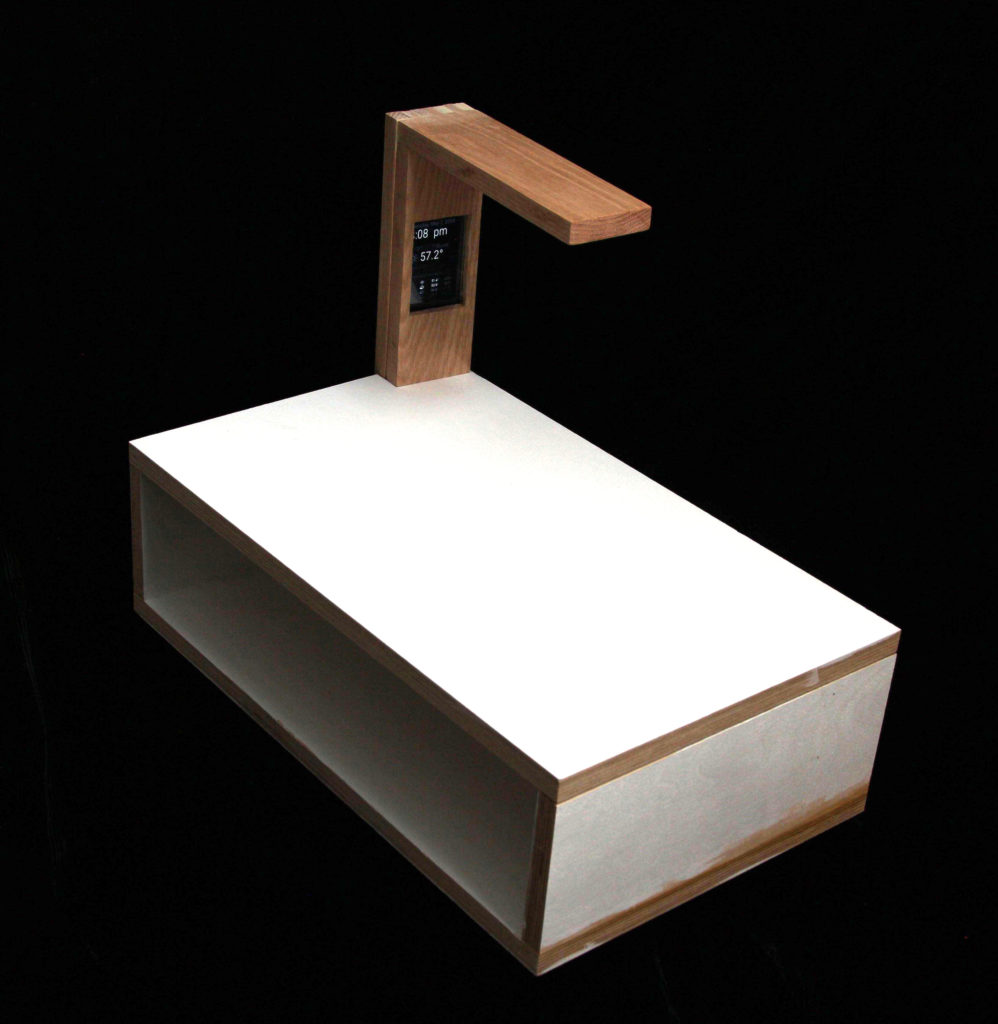
12 Comments. Leave new
wow awesome job on the project. it totally shows that you had spent a lot of time on it. loved all the features and cant wait to see it on expo.
It is clear that you spent a lot of time on this project and I think the final product is really cool. I am very impressed by how much work went into coding the LCD for the light. Honestly the light could have been your final product but you went above and beyond.
It is very impressive that all the electronics are functional and are well integrated with the desk to look clean and seamless. How do you plan on mounting it to the wall and keeping with the floating desk aesthetic?
This project turned out great. Your attention to detail and build quality really paid off. Do the wireless charger and raspberry pi run off the same power source? It may be a nice feature to reduce the number of cords.
Nice! I really like all of the electronics you put into this, as well as the precision in fabrication. If you wanted, I bet you could sand the white paint off and stain the wood with something that would show off the nice grain. Super cool project!
It seems like you are at a great place currently in within the scope of this project. I’m very surprised at how well the LCD turned out and I think that is a great addition to your desk because of how useful it will be in the morning. The leather as well goes well with your overall aesthetic so that’s nice. How do you plan on incorporating the power on and off switch?
Wow, that nightstand is full of features for something so simple at first glance. It is impressive how similar your actual product looks to the CAD you made. I’m curious about how you plan on mounting it to the wall. Or maybe it will be set on something?
The wireless charging is a cool installation. It is nice that you were able to overcome all of the challenges that you encountered with the electronics. Do you think you will use any bronze accents?
Seems pretty technical for a desk. A lot of great features that seem very useful. Hope you can polish it off and it goes well. Great Job!
The wireless charger was a nice touch to the floating dresser, everything will look neater. The auto-updating weather screen is something I actually want to get for my self, especially here in Boulder since the weather is so unpredictable
I really like how you used this project to teach yourself stuff in other areas of engineering. What was the most challenging part of the design? Also, has Art Nouveau?
Nicely done. I like your inspiration for this floating desk. It is great that you thought about your personal desires and included that in the design!